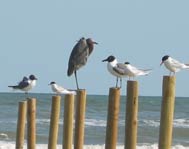Butterflies and Moths of Galveston Island State Park
There are two lists on this webpage. The first is a butterfly checklist based on information from the Texas Naturalist.net. This list includes 148 species that have been observed or are likely to occur on the Texas coast. The primary source for much of this information is the wonderful book Butterflies of Houston and Southeast Texas.
The second list provides a shorter list of butterflies and moths known to occur in Galveston County, Texas. This list is based on verified scientific records ("museum specimens, authoritative monographs or other publications, or records from recognized experts") that are catalogued in a lepidoptera database found at the website Butterflies and Moths of North America. You can also access species specific information from this website, with images, by clicking on the links for each species found in the second list.
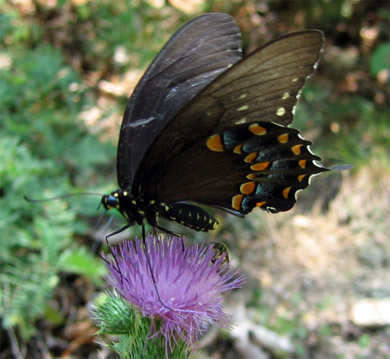
Black Swallowtail
If you are thinking about visiting Galveston Island State Park to look for butterflies but do not have much experience with this wonderful outdoor pursuit, you may want to have a look at this TWPD pamphlet about butterfly watching (this is a 500KB PDF file). It is nice introduction to this subject.
Butterflies have always garnered much more attention than moths due to the greater profusion of showy, colorful butterflies. This has led to there being much more general science information published about butterflies than moths. The following short discussion about butterflies continues in this tradition......
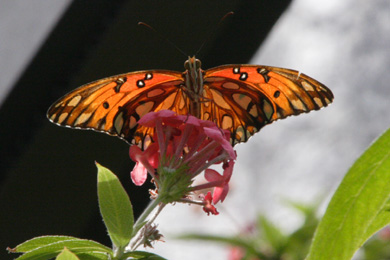 Gulf Fritillary
Gulf Fritillary
photo by Robert Lawton - CC ShareAlike 2.5 license
People have long been fascinated by the beauty and gracefulness of these charismatic animals. In the past this interest has often been limited to offhand encounters that are part of other outdoor pursuits. The fleeting nature of these experiences have only added to their magical quality; a wispy, winged burst of color that drops in on us and then, too quickly, disappears. In a less natural setting, the popularity of greenhouse butterfly gardens and people’s willingness to pay money for an opportunity to walk through these live displays serve as a testament to the fascination that many people hold for butterflies.
Rather than simply enjoying seeing a butterfly as a minor part of their outdoor adventures, more and more people are taking to the field to seek them out. A number of recent developments have, in part, been responsible for this rising popularity. Easy to use binoculars with excellent close focus abilities are one reason for this growing interest. Observing fine details of these insects in the field increases our enjoyment by allowing us to see more of the beautiful characteristics of these delicate animals. Digital cameras have also been a part of the technological innovations that have created more interest in butterfly watching. Being able to see and document many fine details on a butterfly are a great boon when attempting to identify species. Field guides have also improved in many ways: in the quality of the information they provide, in their ease of use, and in there being a growing number of comprehensive regional treatments, such as: Butterflies of West Texas Parks and Preservesand Butterflies Of The Lower Rio Grande
.
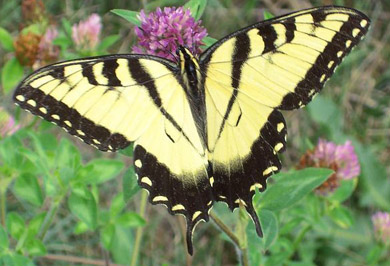
Eastern Tiger Swallowtail
One of the prerequisites of planning a butterfly outing is deciding on where to go. Good habitat can be easy or difficult to find, depending on where one lives. Texas State Parks are good places to visit. They typically provide public access to habitats that were once more common in a local area, as is the case with Galveston Island State Park. It can also be fun to visit state parks in different ecoregions since they contain different habitats which can support different butterfly species.
There are 732 species of butterflies known from North America. More than half of these, 442 species, have been observed in Texas. This is the highest diversity for any US state. This makes butterfly watching in the state an exciting challenge. There is an opportunity to see a great diversity of forms, colors, and sizes of butterflies but this can also make it more difficult to decide the identity of a species. Regardless of your identification abilities, having an opportunity to find and observe these wonderful insects can be a rewarding and fun adventure.
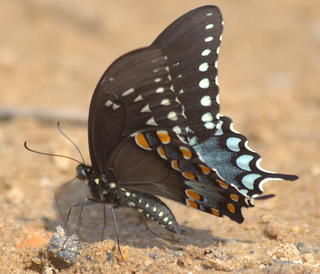
Spicebush Swallowtail
Coastal Texas Butterfly Species
(c) - Common (u) - Less common (r) - rareSWALLOWTAILS, Papilionidae
Pipevine Swallowtail, Battus philenor, (c)
Polydamas Swallowtail, Battus polydamas, (u)
Zebra Swallowtail, Eurytides marcellus, (c)
Black Swallowtail, Papilio polyxenes, (c)
Thoas Swallowtail, Papilio thoas (u)
Giant Swallowtail, Papilio cresphontes, (c)
Tiger Swallowtail Papilio glaucus, (c)
Two-tailed Swallowtail, Papilio multicaudata, (u)
Spicebush Swallowtail, Papilio troilus, (c)
Palamedes Swallowtail, Papilio palamedes, (c)
WHITES and SULPHURS, Pieridae
Tropical White, Appias drusilla, (r)Checkered White, Pontia protodice, (c)
Cabbage White, Pieris rapae, (c)
Great Southern White, Ascia monuste, (c)
Giant White, Ganyra josephina, (r)
Falcate Orangetip, Anthocharis midea, (c)
Clouded Sulphur, Colias philodice, (u)
Orange Sulphur, Colias eurytheme, (c)
Dog Face, Colias cesonia, (c)
White Angled-Sulphur, Anteos chlorinde, (r)
Yellow Angled-Sulphur, Anteos maerula, (r)
Cloudless Sulphur, Phoebis sennae, (c)
Orange-barred Sulphur, Phoebis philea, (u)
Large Orange Sulphur, Phoebis agarithe, (c)
Lyside Sulphur, Kricogonia lyside, (r)
Barred Yellow, Eurema daira, (u)
Mexican Yellow, Eurema mexicana, (c)
Little Sulphur, Eurema lisa, (c)
Sleepy Orange, Eurema nicippe, (c)
Dainty Sulphur, Nathalis iole, (c)
GOSSAMER-WINGED BUTTERFLIES, Lycaenidae
Harvester, Feniseca tarquinius, (c)Great Purple Hairstreak, Atlides halesus, (c)
Soapberry Hairstreak, Phaeostrymon alcestis, (c)
Banded Hairstreak, Satryium calanus, (c)
King's Hairstreak, Satyrium kingi, (u)
Striped Hairstreak, Satyrium liparops, (u)
Northern Hairstreak, Fixsenia favonius, (c)
Frosted Elfin, Callophrys irus, (u)
Henry's Elfin, Callophrys henrici, (c)
Eastern Pine Elfin, Callophrys niphon, (c)
Olive Hairstreak, formerly Juniper, Mitoura grynea, (c)
White-M Hairstreak, Parrhasius m-album, (u)
Gray Hairstreak, Strymon melinus, (c)
Columella Hairstreak, Strymon columella, (r)
Red-banded Hairstreak, Calycopis cecrops, (c)
Dusky-blue Hairstreak, Calycopis isobeon, (c)
Western Pygmy-Blue, Brephidium exile, (c)
Eastern Pygmy-Blue, Brephidium isophthalma, (u)
Cassius Blue, Leptotes cassius, (c)
Marine Blue, Leptotes marina, (c)
Ceraunus Blue, Hemiargus ceraunus, (c)
Reakirt's Blue, Hemiargus isola, (c)
Eastern Tailed-Blue, Everes comyntas, (c)
Spring Azure, Ceslastrina ladon, (c)
METALMARKS, Riodinidae
Little Metalmark, Calephelis virginiensis, (c)SNOUT BUTTERFLIES, Libytheidae
Snout Butterfly, Libytheana bachmanii, (c)LONGWINGS, heliconiidae
Gulf Fritillary, Agraulis vanillae, (c)Julia, Dryas iulia, (c)
Zebra, Heliconius charitonius, (c)
NYMPHALIDS, Nymphalidae
Variegated Fritillary, Euptoieta claudia, (c)Bordered Patch, Chlosyne lacinia, (c)
Gorgone Checkerspot, Chlosyne gorgone, (u)
Silvery Checkerspot, Chlosyne nycteis, (c)
Texan Crescent, Phyciodes texana, (c)
Phaon Crescent, Phyciodes phaon, (c)
Pearl Crescent, Phyciodes tharos, (c)
Question Mark, Polygonia interrogationis, (c)
Eastern Comma, Polygonia comma, (u)
Mourning Cloak, Nymphalis antiopa, (c)
American Painted Lady, Vanessa virginiensis, (c)
Painted Lady, Vanessa cardui, (c)
Red Admiral, Vanessa atalanta, (c)
Buckeye, Junonia coenia, (c)
Red-spotted Purple, Limenitis arthemis astyanax, (c)
Viceroy, Limenitis archippus, (c)
California Sister, Adelpha bredowii, (r)
Blue-eyed Greenwing, Dynamine dyonis, (r)
Amymone, Mestra amymone, (c)
Goatweed Leafwing, Anaea andria, (c)
Hackberry Emperor, Asterocampa celtis, (c)
Tawny Emperor, Asterocampa clyton, (c)
SATYRS, WOOD NYMPHS, and BROWNS, Satyridae
Southern Pearly Eye, Enodia portlandia, (c)Creole Pearly Eye, Enodia creola, (u)
Gemmed Satyr, Cyllopsis gemma, (c)
Carolina Satyr, Hermeuptychia sosybius, (c)
Georgia Satyr, Neonympha areolata, (c)
Little Wood Satyr, Megisto cymela, (c)
Red Satyr, Megisto rubricata, (u)
Common Wood Nymph, Cercyonis pegala, (c)
MILKWEED BUTTERFLIES, Danaidae
Monarch, Danaus plexippus, (c)Queen, Danaus gilippus, (c)
SKIPPERS, Hesperiidae
Silver-spotted Skp., Epargyreus clarus, (c)White-striped Longtail, Chiodes catillus, (u)
Long-tailed Skp., Urbanus proteus, (c)
Dorantes Longtail, Urbanus dorantes, (c)
Hoary Edge, Achalarus lyciades, (u)
Southern Cloudywing, Thorybes bathyllus, (u)
Northern Cloudywing, Thorybes pylades, (c)
Confused Cloudywing, Thorybes confusis, (u)
Southern Scalloped Sootywing, Staphylus mazans, (r)
Scalloped Sootywing, Staphylus hayhurstii, (r)
Sickle-winged Skp., Achlyodes mithridates, (c)
White-patched Skp., Chiomara asychis, (r)
False Duskywing, Gesta gesta, (r)
Sleepy Duskywing, Erynnis brizo, (r)
Juvenal's Duskywing, Erynnis juvenalis, (c)
Horace's Duskywing, Erynnis horatius, (c)
Funereal Duskywing, Erynnis funeralis, (c)
Wild Indigo Duskywing, Erynnis baptisiae, (c)
Common Checkered-Skp., Pyrgus communis (c)
Tropical Checkered-Skp., Pyrgus oileus, (c)
Common Sootywing, Pholisora catullus, (r)
Swarthy Skp., Nastra lherminier, (c)
Julia's Skp., Nastra julia, (c)
Neamathla Skp., Nastra neamathla, (c)
Clouded Skp., Lerema accius, (c)
Least Skp., Ancyloxypha numitor, (c)
Orange Skipperling, Copaeodes aurantiacus, (u)
Southern Skipperling, Copaeodes minimus, (c)
Fiery Skp., Hylephila phyleus, (c)
Meske's Skp., Hesperia meskei, (r)
Tawny-edged Skp., Polites themistocles, (r)
Crossline Skp., Polites origenes, (r)
Whirlabout, Polites vibex, (c)
Southern Broken-Dash, Wallengrenia otho, (c)
Northern Broken-Dash, Wallengrenia egeremet, (u)
Little Glassywing, Pompeius verna, (c)
Sachem, Atalopedes campestris, (c)
Arogos Skp., Atrytone arogos, (r)
Delaware Skp., Atrytone logan, (r)
Byssus Skp., Problema byssus, (r)
Zabulon Skp., Poanes zabulon, (r)
Aaron's Skp., Poanes aaroni, (r)
Yehl Skp., Poanes yehl, (u)
Broad-winged Skp., Poanes viator, (c)
Dukes' Skp., Euphyes dukesi, (r)
Dun Skp., Euphyes vestris, (c)
Lace-winged Roadside-Skp., Amblyscirtes aesculapius, (c)
Common Roadside-Skp., Amblyscirtes vialis, (c)
Celia's Roadside-Skp., Amblyscirtes celia, (c)
Dusky Roadside-Skp., Amblyscirtes alternata, (c)
Eufala Skp., Lerodea eufala, (c)
Twin-spot Skp., Oligoria maculata, (c)
Brazilian Skp., Calpodes ethlius, (c)
Salt Marsh Skp., Panoquina panoquin, (c)
Obscure Skp., Panoquina panoquinoides, (c)
Ocola Skp., Panoquina ocola, (c)
Yucca Giant-Skp., Megathymus yuccae, (u)

Monarch
The Butterflies and Moths of Galveston County, Texas
Brush-footed Butterflies (Nymphalidae)
Admirals and Relatives (Limenitidinae)
'Astyanax' Red-spotted Purple (Limenitis arthemis astyanax)Emperors (Apaturinae)
Hackberry Emperor (Asterocampa celtis)Tawny Emperor (Asterocampa clyton)
Leafwings (Charaxinae)
Goatweed Leafwing (Anaea andria)Longwings (Heliconiinae)
Gulf Fritillary (Agraulis vanillae)Variegated Fritillary (Euptoieta claudia)
Milkweed Butterflies (Danainae)
Monarch (Danaus plexippus)Satyrs and Wood-Nymphs (Satyrinae)
Carolina Satyr (Hermeuptychia sosybius)Gemmed Satyr (Cyllopsis gemma)
Little Wood Satyr (Megisto cymela)
Snouts (Libytheinae)
American Snout (Libytheana carinenta)True Brushfoots (Nymphalinae)
Common Buckeye (Junonia coenia)Painted Lady (Vanessa cardui)
Phaon Crescent (Phyciodes phaon)
Red Admiral (Vanessa atalanta)
Gossamer-wing Butterflies (Lycaenidae)
Blues (Polyommatinae)
Ceraunus Blue (Hemiargus ceraunus)Eastern Pygmy-Blue (Brephidium pseudofea)
Eastern Tailed-Blue (Cupido comyntas)
Marine Blue (Leptotes marina)
Reakirt's Blue (Echinargus isola)
Spring Azure (Celastrina "ladon")
Summer Azure (Celastrina neglecta)
Western Pygmy-Blue (Brephidium exilis)
Hairstreaks (Theclinae)
Dusky-blue Groundstreak (Calycopis isobeon)Gray Hairstreak (Strymon melinus)
Red-banded Hairstreak (Calycopis cecrops)
Soapberry Hairstreak (Phaeostrymon alcestis)
Southern Hairstreak (Satyrium favonius)
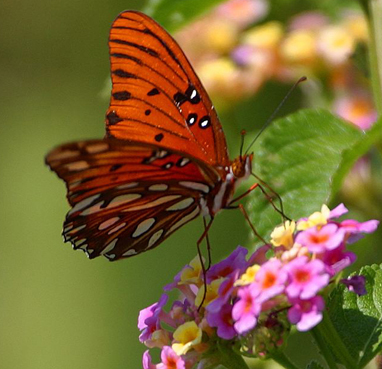
A photo of a Gulf Fritillary courtesy of the website PD photo.
Metalmarks (Riodinidae)
Little Metalmark (Calephelis virginiensis)Parnassians and Swallowtails (Papilionidae)
Swallowtails (Papilioninae)
Black Swallowtail (Papilio polyxenes)Eastern Tiger Swallowtail (Papilio glaucus)
Giant Swallowtail (Papilio cresphontes)
Pipevine Swallowtail (Battus philenor)
Polydamas Swallowtail (Battus polydamas)
Spicebush Swallowtail (Papilio troilus)
Two-tailed Swallowtail (Papilio multicaudata)
Prominents (Notodontidae)
Datana diffidens (Datana diffidens)Skippers (Hesperiidae)
Grass Skippers (Hesperiinae)
Brazilian Skp. (Calpodes ethlius)Broad-winged Skp. (Poanes viator)
Celia's Roadside-Skp. (Amblyscirtes celia)
Clouded Skp. (Lerema accius)
Dun Skp. (Euphyes vestris)
Eufala Skp. (Lerodea eufala)
Fiery Skp. (Hylephila phyleus)
Julia's Skp. (Nastra julia)
Neamathla Skp. (Nastra neamathla)
Obscure Skp. (Panoquina panoquinoides)
Sachem (Atalopedes campestris)
Salt Marsh Skp. (Panoquina panoquin)
Southern Broken-Dash (Wallengrenia otho)
Southern Skipperling (Copaeodes minima)
Swarthy Skp. (Nastra lherminier)
Tawny-edged Skp. (Polites themistocles)
Twin-spot Skp. (Oligoria maculata)
Whirlabout (Polites vibex)
Spread-wing Skippers (Pyrginae)
False Duskywing (Gesta invisus)Funereal Duskywing (Erynnis funeralis)
Horace's Duskywing (Erynnis horatius)
Juvenal's Duskywing (Erynnis juvenalis)
Long-tailed Skp. (Urbanus proteus)
Mercurial Skp. (Proteides mercurius)
Silver-spotted Skp. (Epargyreus clarus)
Southern Cloudywing (Thorybes bathyllus)
Tailed Aguna (Aguna metophis)
Sphinx Moths, Hawkmoths (Sphingidae)
Macroglossinae (Macroglossinae)
Fadus sphinx (Aellopos fadus)Sphinginae (Sphinginae)
Gemmed sphinx (Sphinx geminus)Streaked sphinx (Protambulyx strigilis)
Tiger Moths and Lichen Moths (Arctiidae)
Tiger Moths (Arctiinae)
Orange Holomelina (Holomelina aurantiaca)Whites and Sulphurs (Pieridae)
Sulphurs (Coliadinae)
Clouded Sulphur (Colias philodice)Cloudless Sulphur (Phoebis sennae)
Dainty Sulphur (Nathalis iole)
Orange Sulphur (Colias eurytheme)
Sleepy Orange (Abaeis nicippe)
Yellow Angled-Sulphur (Anteos maerula)
Whites (Pierinae)
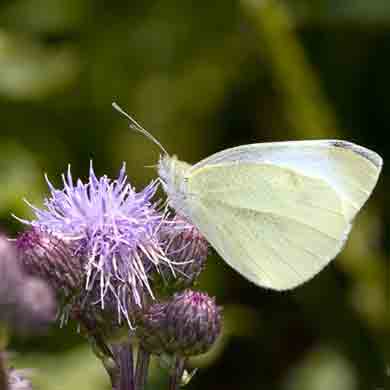
Pieris rapae one of the most common and widespread butterflies in North America
photo by Olaf Leillinger - CC Attribution-ShareAlike 2.5 license
Cabbage White (Pieris rapae)
Checkered White (Pontia protodice)
Falcate Orangetip (Anthocharis midea)
Giant White (Ganyra josephina)
Great Southern White (Ascia monuste)
Wild Silk Moths (Saturniidae)
Royal Moths (Citheroniinae)
Sphingicampa albolineata (Sphingicampa albolineata)
Return to the top of this page
